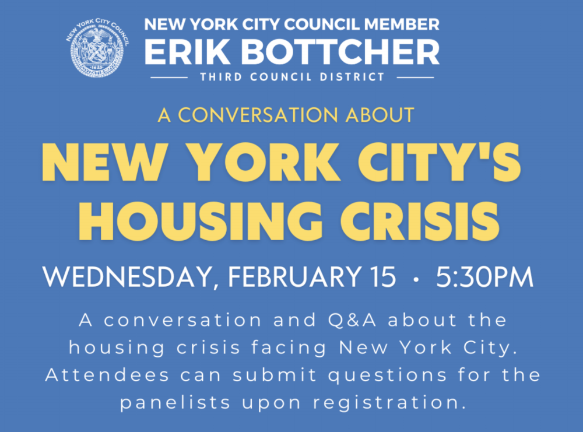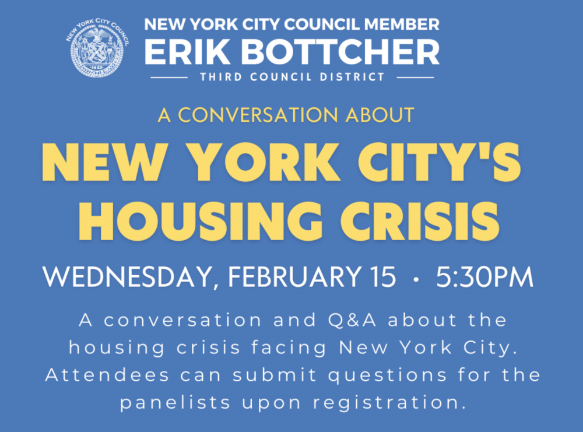Several top politicians warned in a virtual forum that the city we all know could be “lost” unless leaders start to take drastic action to address the brewing housing crisis in the city now.
“If the current trend continues and if the cost of housing continues to rise, I believe we will lose the New York City that we know,” said Councilman Erik Bottcher, who represents a district that includes Chelsea, the West Village, Hudson Square, the Garment District, Flatiron and parts of Greenwich Village.
The forum also drew the head of the NYC Planning Commission, Dan Garodnick himself a former city councilman representing Stuyvesant Town and the Upper East Side, and Jessica Katz, Chief Housing Officer for New York City. Bottcher, Garodnick and Katz spoke candidly about the dearth of affordable housing in New York City and stressed the importance of finding expedient solutions.
“If the current trends continue...we could have a city with hundreds of thousands of people living in the shelter system, a city where the only way to get an apartment you can afford is by winning a housing lottery—and that is a city that none of us want to live in,” said Bottcher.
Bottcher also expressed optimism as to the city’s ability to remedy its affordable housing crisis, but said that for that to happen, “We’ve got to make the right decisions; we’ve got to make bold policy choices.”
The city’s affordable housing shortage has been an ongoing issue for a long time. In the early days of COVID-19, many people who could afford to had fled the city and according to some estimates as many as 500,000 left in the early days of the pandemic, forcing landlords to lower rents or dangle free months as an enticement to get tennants to return and sign leases. But the brief respite is over. As the city’s population rebounded to pre-pandemic levels, rental prices skyrocketed. Rents are now higher than they were before the pandemic. According to a report from Governor Kathy Hochul, rents have risen 30 percent since 2015 and home prices have risen 50 percent over the same eight year period in the New York City metro area.
But all is not hopeless. Garodnick clarified that while New York is indeed a densely built and populated city, the perception that it is too dense to create new housing is erroneous.
“In some places New York is really densely built,” he said, “[but] in some places it is not. And we need to take a look at all of our policies, including historically exclusionary zoning practices, and find opportunities for us to think about this problem on a citywide basis.”
The conversation came days after Manhattan borough president Mark Levine unveiled a housing plan which could add over 70,000 new units in the borough, and echoed much of what Levine said about the dire need for new housing units to be built. Levine’s plan identified up to 171 buildable lots in the city that could support new affordable housing. While Brooklyn started 11,000 new housing units last year, he said Manhattan had only 3,000 new starts and that new housing often meets stiff local resistance from area residents.
“To say that you just don’t want to build any more housing, that can’t be an acceptable outcome anymore,” Levine had stated when unveiling his plan. He is pushing for a borough-wide plan to create new units, and highlighted nine different neighborhoods across Manhattan where zoning changes could spur the building of new affordable housing in the borough.
Katz estimated in the forum that to remedy the crisis, the number of new housing units needed acorss the city would need to be in the hundreds of thousands. “The current best guess looks like, statewide, we would need something like 3/4 of a million to a million apartments across the board. It’s hundreds of thousands by anyone’s measure right here in the city.”
Low vacancy rates for existing housing, however, were also mentioned as a major issue.
“Our vacancy rate is at record lows,” said Garodnick. “4.5% on average, and for apartments below 1500 a month it’s less than 1% vacancy. When you think about what is a healthy vacancy rate for a city, you’re thinking more like 7% or 8%. And what it means when you have low vacancy is there can really be very few tenant protections. You see the impacts on human beings where you have 50% of New Yorkers who are rent-burdened. You see ... an imbalance between landlords and tenants out there, because tenants have few options.”
Continuing efforts to help New Yorkers find affordable housing, Bottcher’s office is hosting clinics with members of the Mayor’s Public Engagement Unit on the second Thursday of every month to help eligible constituents enroll in rent freeze programs. Their next clinic is scheduled for March 9th. Constituents can visit the district office (224 W 30th Street, #1206) that day from 10:30am to 5:00pm.
“If the current trends continue, if the cost of housing continues to rise, I believe we will lose the New York City that we know.” Erik Bottcher, NYC Councilman, 3rd District.

